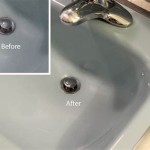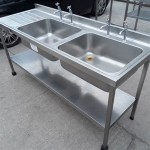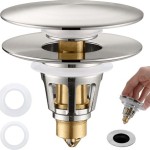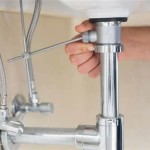How To Caulk Around a Sink: A Comprehensive Guide
Caulking around a sink is a crucial maintenance task that prevents water damage, mold growth, and keeps plumbing fixtures securely in place. Properly applied caulk creates a watertight seal between the sink and the countertop, backsplash, or wall. This guide provides a detailed overview of the process, from selecting the right materials to executing a professional-looking caulk bead.
Understanding the Importance of Caulking
Caulking acts as a barrier against moisture intrusion. Without a proper seal, water can seep behind the sink, leading to rot, structural damage, and the proliferation of mold and mildew. Mold poses health risks and can be difficult and costly to remediate. Furthermore, the caulk helps to secure the sink, preventing movement that can stress plumbing connections and potentially cause leaks elsewhere. Regular inspection and maintenance of caulk lines are essential for preventing these problems.
The aesthetic appeal of caulk should also be considered. A clean, uniform bead of caulk enhances the overall appearance of the sink and its surroundings, creating a more polished and professional look. Old, cracked, or discolored caulk detracts from the visual appeal of the space and should be replaced promptly.
Materials and Tools Required
Successful caulking requires the correct tools and materials. Gathering these items before beginning the project ensures a smooth and efficient process.
*Caulk:
Silicone caulk is generally recommended for sinks due to its excellent water resistance and flexibility. Acrylic latex caulk is another option sometimes used, but it is less durable in wet environments. The caulk should be mildew-resistant to prevent the growth of mold. *Caulk Gun:
A caulk gun is necessary for dispensing the caulk from the tube. Choose a high-quality caulk gun that provides smooth and consistent pressure. *Caulk Removal Tool:
A specialized caulk removal tool simplifies the process of removing old caulk. These tools are available in various designs, including scrapers and multi-tools. *Utility Knife:
A sharp utility knife can be used to score and cut the old caulk, especially in tight corners. *Scraper or Putty Knife:
A scraper or putty knife helps to remove any remaining caulk residue after the initial removal process. *Cleaning Supplies:
A cleaner, such as denatured alcohol or a mildew cleaner, is needed to clean the surface before applying new caulk. A dry cloth or paper towels are also necessary. *Masking Tape:
Masking tape is used to create clean and precise caulk lines. *Caulk Smoothing Tool or Finger:
A caulk smoothing tool or a gloved finger is used to create a smooth and uniform bead of caulk. *Gloves:
Wearing gloves protects hands from caulk and cleaning solutions. *Safety Glasses:
Safety glasses should be worn to protect eyes from debris and cleaning solution splashes. *Old toothbrush:
An old toothbrush can be helpful for scrubbing away stubborn caulk residue or mold.Step-by-Step Caulking Procedure
The following steps outline the correct procedure for caulking around a sink.
1.Preparation:
The first step involves preparing the work area. This includes removing any items from the sink area that could obstruct the process. Protect the surrounding surfaces with drop cloths if necessary. Ensure adequate ventilation in the work area, especially when using cleaning solutions. 2.Removing Old Caulk:
Removing old caulk is a crucial step for proper adhesion of the new caulk. Using the caulk removal tool or utility knife, carefully score along the edges of the old caulk. Then, use the tool to pry the caulk away from the sink and countertop. Take care not to damage the sink or countertop surfaces. 3.Cleaning the Surface:
Thoroughly clean the area with a cleaner such as denatured alcohol or a mildew cleaner. Remove any remaining caulk residue, dirt, or grime. Allow the surface to dry completely before proceeding. A dry surface is essential for proper adhesion. Check for any signs of mold or mildew and treat the area accordingly with a fungicide cleaner. Rinse any cleaner residue and dry thoroughly. Ensuring a clean and dry surface is vital for a successful and long-lasting caulk application. 4.Applying Masking Tape:
Apply masking tape along both sides of the area to be caulked, creating a defined line for the caulk bead. The tape should be applied consistently and evenly, ensuring that it aligns with the desired caulk line. This step creates clean and professional-looking caulk lines. The masking tape acts as a template, preventing caulk from spreading onto unwanted areas. Press the tape firmly to the surface to prevent caulk from seeping underneath. 5.Loading the Caulk Gun:
Cut the tip of the caulk tube at a 45-degree angle, adjusting the size of the opening based on the desired caulk bead thickness. Insert the caulk tube into the caulk gun and advance the plunger until it makes contact with the tube. This step prepares the caulk gun for dispensing caulk. 6.Applying the Caulk:
Place the caulk gun at a 45-degree angle to the surface and apply a consistent bead of caulk along the joint. Apply steady pressure to the caulk gun trigger to ensure a uniform flow of caulk. Avoid applying too much caulk at once, as it is easier to remove excess caulk than to add more. Work in sections, applying a bead of caulk along a manageable length. 7.Smoothing the Caulk:
Immediately after applying the caulk, smooth the bead using a caulk smoothing tool or a gloved finger. Apply gentle pressure and move the tool or finger along the caulk line in a smooth, continuous motion. This step creates a uniform and professional-looking finish. Remove any excess caulk with a damp cloth or paper towel. 8.Removing the Masking Tape:
Carefully remove the masking tape while the caulk is still wet. Pull the tape away at a 45-degree angle to avoid disturbing the caulk bead. This step reveals clean and precise caulk lines. 9.Curing Time:
Allow the caulk to cure completely according to the manufacturer's instructions. This typically takes 24 to 48 hours. Avoid using the sink during the curing process to ensure proper adhesion.Addressing Common Caulking Problems
Several common problems can occur during the caulking process. Understanding these issues and how to address them can help ensure a successful outcome.
*Uneven Caulk Bead:
An uneven caulk bead can be caused by inconsistent pressure on the caulk gun or by not smoothing the caulk properly. To correct this, use a caulk smoothing tool or a gloved finger to even out the bead. If the caulk has already started to dry, use a utility knife to carefully remove the uneven section and reapply caulk. *Air Bubbles:
Air bubbles can occur if the caulk is not applied evenly or if there is moisture trapped beneath the caulk. To prevent air bubbles, ensure that the surface is completely dry before applying caulk. Apply the caulk in a smooth, continuous motion and avoid trapping air beneath the bead. If air bubbles do occur, use a caulk smoothing tool or a pin to puncture the bubbles and smooth out the caulk. *Poor Adhesion:
Poor adhesion can be caused by a dirty or damp surface, or by using the wrong type of caulk. To ensure proper adhesion, clean the surface thoroughly and allow it to dry completely before applying caulk. Use a high-quality silicone caulk that is specifically designed for use in wet environments. *Mold Growth:
Mold growth can occur if the caulk is not mildew-resistant or if moisture is allowed to accumulate behind the caulk. To prevent mold growth, use a mildew-resistant caulk and ensure that the area is properly ventilated. Regularly clean the caulk with a mildew cleaner to prevent the growth of mold. If mold does occur, remove the old caulk and clean the area thoroughly with a mildew cleaner before applying new caulk. *Cracking and Shrinking:
Caulking can crack or shrink over time due to temperature changes, movement of the sink or countertop, or the use of low-quality caulk. To prevent cracking and shrinking, use a high-quality silicone caulk that is flexible and durable. Avoid using acrylic latex caulk in areas that are subject to frequent temperature changes or movement.Tips for a Professional Finish
Achieving a professional-looking caulk job requires attention to detail and proper technique.
*Practice:
Practice applying caulk on a piece of scrap material before working on the sink area. This allows one to develop a feel for the caulk gun and the smoothing process. *Use a Caulk Gun with Adjustable Flow Control:
A caulk gun with adjustable flow control allows one to precisely control the amount of caulk dispensed, preventing over-application. *Clean as You Go:
Wipe away any excess caulk immediately with a damp cloth or paper towel. This prevents the caulk from drying and becoming difficult to remove. *Choose the Right Caulk Color:
Select a caulk color that matches the sink or countertop for a seamless appearance. *Inspect Regularly:
Regularly inspect the caulk lines for any signs of cracking, shrinking, or mold growth. Address any issues promptly to prevent further damage.By following these steps and tips, one can successfully caulk around a sink and create a watertight seal that protects the area from water damage and mold growth. Proper caulking requires careful preparation, the right materials, and attention to detail. Regular maintenance and inspection of the caulk lines are essential for ensuring long-lasting protection.

How To Re Caulk A Sink

Caulking Around A Kitchen Sink

Diy Remove Caulk And Replace In Kitchen Sink Dap Global
How To Re Caulk A Bathroom Sink Ifixit Repair Guide

How To Caulk A Kitchen Sink Waypoint Inspection

Here S How To Caulk Around Bathroom And Kitchen Fixtures
How To Re Caulk A Bathroom Sink Ifixit Repair Guide

Easy How To Replace The Silicone On An Undercounter Sink

How To Caulk The Kitchen Sink Easy Step By Guide

How To Caulk A Bathroom Sink Faucet Detailed Guide







